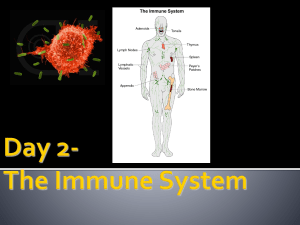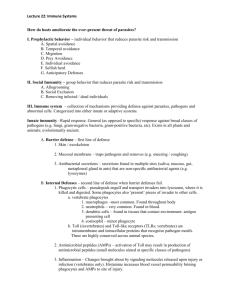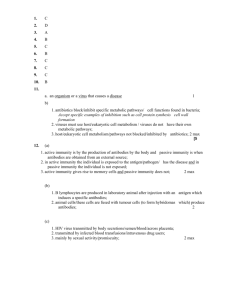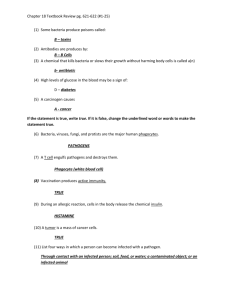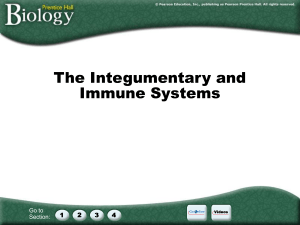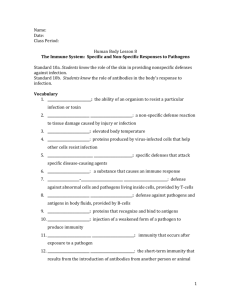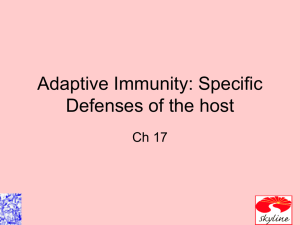Chapter 44 – The Immune System: Internal Defense Immune
advertisement
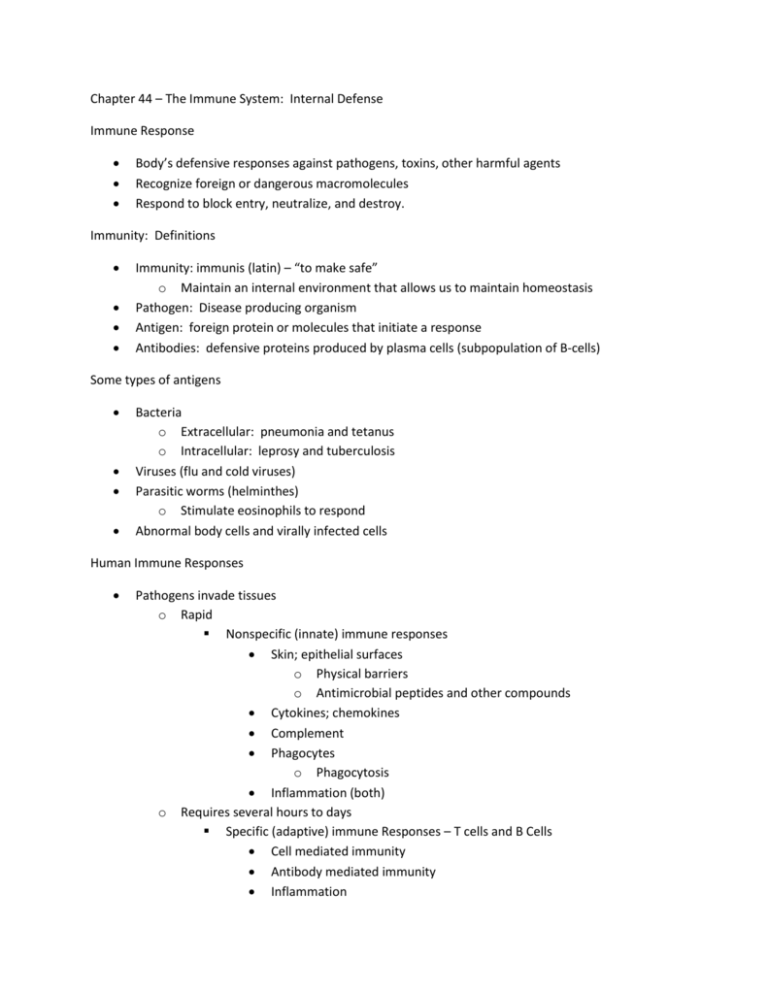
Chapter 44 – The Immune System: Internal Defense Immune Response Body’s defensive responses against pathogens, toxins, other harmful agents Recognize foreign or dangerous macromolecules Respond to block entry, neutralize, and destroy. Immunity: Definitions Immunity: immunis (latin) – “to make safe” o Maintain an internal environment that allows us to maintain homeostasis Pathogen: Disease producing organism Antigen: foreign protein or molecules that initiate a response Antibodies: defensive proteins produced by plasma cells (subpopulation of B-cells) Some types of antigens Bacteria o Extracellular: pneumonia and tetanus o Intracellular: leprosy and tuberculosis Viruses (flu and cold viruses) Parasitic worms (helminthes) o Stimulate eosinophils to respond Abnormal body cells and virally infected cells Human Immune Responses Pathogens invade tissues o Rapid Nonspecific (innate) immune responses Skin; epithelial surfaces o Physical barriers o Antimicrobial peptides and other compounds Cytokines; chemokines Complement Phagocytes o Phagocytosis Inflammation (both) o Requires several hours to days Specific (adaptive) immune Responses – T cells and B Cells Cell mediated immunity Antibody mediated immunity Inflammation Invertebrates and Vertebrates Invertebrates o Nonspecific immune responses Physical, phagocytic, physiological and inflammatory Physical barriers (cuticle, epithelium) Phagocytosis Antimicrobial peptides (soluble,lyse membranes, destroy pathogens) Anything that destroys from a chemical standpoint. Vertebrates o Both nonspecific and specific immune responses First-Line Defenses Physical barriers o Skin o Mucous linings of respiratory, digestive tracts Antimicrobial peptides o Produced by epithelial membranes pH in stomach and acidic secretions onto surface of Skin Mucus HCl may not necessarily destroy all pathogens in the digestive tract Chemical Defenses Lysozyme in tears and saliva lyse bacterial walls o Essentially punch holes in the surface of the bacterium causing them to have a chemical imbalance and lyse. Nonspecific Immune Cells Phagocytes destroy bacteria o Neutrophils o Macrophages Natural Killer (NK) cells destroy cells infected with viruses o Foreign or altered (tumor cells) o In our system at all times Cytokines Signaling proteins regulate interactions between cells Interferons o Inhibit viral replication o Activate natural killer cells o Produced by cells that are virally infected Tumor necrosis factor (TNF) o Initiates inflammatory response Interleukins o Help regulate interactions between lymphocytes and other body cells o Help mediate inflammation and fever Chemokines o Attract, activate, direct movement of certain immune system cells. Complement Proteins Enhance inflammatory response Lyse cell wall of pathogens Coat pathogens (enhancing phagocytosis) Attract white blood cells to site of infection Refer to image in book – Pathogens invade Tissues Cells are injured Activates molecules in plasma, mast cells, macrophages o Vasodilation Increased blood flow to area Brings phagocytes, nutrients antibodies Redness Increased temperature o Increased capillary permeability Antibodies pass from blood into inflamed area Edema pain o Phagocytes migrate to region Increased phagocytosis Systemic Response Release TNF, IL-1 o Fever Temperature (fever) A systemic response to mediators released at site of inflammation Inhibits growth of many pathogens Body temperature rises about 37.2C in response to pyrogens Mobilizes defenses; accelerates repairs; inhibits pathogens o Tends to decrease the ability of the invader to replicate Acquired (adaptive, specific) immunity Acquired immunity – produced by prior exposure or antibody production o Active immunity Produced by antibodies that develop in response to antigens (Immune response Naturally acquired immunity – develops after exposure to antigens in environment Induced active immunity – develops after administration of antigen to prevent diseases o Passive Immunity Produced by transfer of antibodies from another person Induced passive immunity – conferred by administration of antibodies to combat infection Natural passive immunity – conferred by transfer of maternal antibodies across placenta or in breast milk o Adaptive immunity involves specific cells called lymphocytes Similarities in Animals and Human specific Immunity Specific (adaptive, acquired) response directed focused on individual organism or antigen Molecular biology indicated adaptive (specific) immunity arose in jawed vertebrates as a result of a viral infection [My laptop died so I missed this last one] Lymphatic System Living and nonliving components Systemic (not localized) response Defensive functions – neutralize and destroy Non immune functions – o Return excess interstitial fluid and filtered back to circulatory system o Transport lipids absorbed from digestive tract to circulatory system. Lymphatic system connects to all parts of the body Lymph nodes are accumulated in the axillary, groin, and jugular areas. Lymphatic capillaries Flaplike – flaps are anchored so that as fluid pressure increases the flaps open. As fluid is absorbed the flap closes Not selective Bone Marrow and Thymus are primary lymphoid organs Site of cell development and immunocompetence Cells that migrate from the bone marrow to the thymus are called T-cells Those that remain in the bone are B-Cells Bone o NK cells o Macrophages Work with T cells – antigen presenting cells o Monocyte Dendritic cells Work with T-cells – Antigen Presenting cells o T-Cells Memory T cells T- cytotoxic cells T Helper cells – cooperate with B-Cells The last 2 are part of cell mediated immunity o B-Cells Migrate to lymph nodes Plasma cell Memory Cell Primary – where they’re produced Secondary (peripheral) – organs and tissues Lymphocytes reside here and is where it makes contact with the antigen and mounts a response Examples: spleen, lymph nodes, tonsils, payers patches (tissues in the intestine) Immunocompetence Successful immune response require recognition of foreign organisms and substances Is selection against T cells and B cells that recognize self and other cells that do not – those that recognize self are destroyed B-cells in bone marrow, T-cells in Thymus Genetic rearrangement provides for ability to recognize a large number of different organisms and antigens


